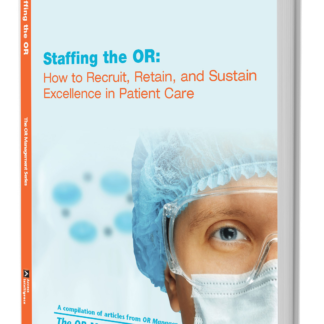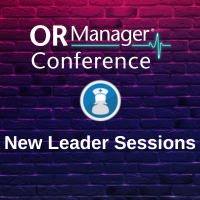Description
This package includes the most popular and trending session recordings compiled from breakout and general sessions at the 2022 OR Business Management Conference. After viewing the content, complete a brief quiz and evaluation to earn 7 CEs.
Presentations include:
- Staffing in a Post-COVID Labor Market
- Managing Cost of Surgical Care: Unforeseen Opportunities Caring for Patients Amid a Pandemic
- Financial Implications of Unprofessional Behavior in the OR
- Strategies to Successfully Prepare and Survive a CMS Survey
- Herding Vendors and All the Trays They Carry
- Keynote: Turn Your Workplace Into a WOWplace – 5 Rules for Leading Your OR Suite to Success
- Keynote: Cybersecurity Risk Management – Protecting Your OR and Your Bottom Line
Learn about each session below:
Staffing in a Post-COVID Labor Market
In this post-COVID labor market, healthcare employers need to have the ability to aggressively compete for qualified team members. According to the Bureau of Labor Statistics as of September 2021, the healthcare sector ranked one of the highest in job separations leaving 42% of the open positions that were reported unfilled. Whether your perioperative department is part of a large hospital system or an independent facility, it is important to develop strategies to create interest that will not only attract applicants to your organization, but will also entice them to commit to working with you after the interview. It is also important to recognize that some recruitment methods can have a negative effect on an organization’s most important resources – current and tenured team members.
We will explore current methods being used to recruit new talent into healthcare organizations. We will also discuss strategies to ensure your organization is competitive in the job market, including mitigating effects of recruiting incentives on your current team.
Learning Objectives:
- Identify at least three staff recruitment strategies currently being used in the healthcare environment.
- Identify key points to discuss during the interview process that can set you apart from other facilities.
- Discuss strategies to mitigate the negative effects of strong recruitment methods on staff retention.
Managing Cost of Surgical Care: Unforeseen Opportunities Caring for Patients Amid a Pandemic
Escalating costs in today’s perioperative environment are a significant concern, undermining the financial viability of many hospitals amid the pandemic. Hospitals are facing extraordinary challenges effectively balancing the cost of clinical care, managing escalating medical supply costs, and addressing capacity issues with higher acuity and increased co-morbidities among patients. Creating a multifaceted approach to address these issues requires “all hands-on-deck” and innovative solutions led collectively by nurses, physicians, and hospital administrators.
A tertiary, academic medical center has implemented a multidimensional strategy to effectively address and monitor these issues. The roadmap begins with ensuring the clinical care is completed in the most appropriate environment. Transitioning elective outpatient procedures from a traditional inpatient OR environment to an ambulatory setting is not only cost effective, but is often driven by patient- and family-centered care amenities. The team developed a methodology to review elective outpatient procedures based on clinical, regulatory, environment, supplies and equipment, and staffing competencies required for the procedures.
The ability to transition elective outpatient procedures to the appropriate environment of care also created additional capacity for the surgical inpatient hospital needs. Providing cost transparency information to the surgeons and clinical teams created the opportunity to decrease cost of care by creating a cost-per-case receipt at the conclusion of each surgical procedure. Optimizing inventory and supplies by increasing ownership among the multidisciplinary committee managing value analysis, new product entry, and supply standardization created additional savings.
Learning Objectives:
- Describe innovative strategies to ensure high quality care in an era of a rapidly changing financial landscape.
- Define three strategies to reduce overall cost of surgical care and ensure quality outcomes.
- Assess the strategies to successfully transition surgical outpatient procedures performed in an inpatient hospital environment to an ambulatory surgery center.
Financial Implications of Unprofessional Behavior in the OR
This interactive presentation will focus on the financial and quality implications of unprofessional behavior in the OR. Participants will define behavior that is a risk to patient safety and leads to poor outcomes; discuss the importance of a culture where co-workers feel safe to report these behaviors and trust the organization will address them; and become familiar with a process to address patterns of behavior inconsistent with the values of the organization. Attendees will be able to define unprofessional behavior in the OR and its impact on team effectiveness and patient outcomes; discuss research that associates unprofessional behavior with higher malpractice costs and poorer surgical outcomes; and identify a tool and process to promote professional accountability and address observations of unprofessional behavior in the OR.
Learning Objectives:
- Define unprofessional behavior in the OR and its impact on team effectiveness and patient outcomes.
- Discuss research that associates unprofessional behavior with higher malpractice costs and poorer surgical outcomes.
- Identify a tool and process to Promote Professional Accountability and address observations of unprofessional behavior in the OR.
Strategies to Successfully Prepare and Survive a CMS Survey
Unannounced CMS surveys are a reality for centers providing surgical services to Medicare and/or Medicaid beneficiaries. Even centers who choose the route of deemed status through accreditation from entities such as JCAHO or AAAHC are not exempt from this anxiety provoking experience, as one could encounter a CMS validation survey following their deemed status survey or a focused complaint survey. Knowledge and understanding of the CMS conditions for participation and corresponding interpretative guidelines provide an awareness as well as a roadmap for overall compliance. Proactive efforts aligned with ongoing preparation and staff awareness of what to expect during the survey process can foster a more positive experience and a successful survey outcome. Attendees will be able to discuss the types of unannounced CMS surveys a facility could expect to undergo; identify proactive activities that can be taken to foster a state of ongoing preparedness; and discuss what to expect during the actual survey process.
Learning Objectives:
- Discus the types of unannounced CMS surveys a facility could expect to undergo.
- Identify proactive activities that can be taken to foster a state of ongoing preparedness.
- Discuss what to expect during the actual survey process.
Herding Vendors and All the Trays They Carry
The purpose of this session is to present our experience with tackling the complex challenges related with vendor tray management. Limited storage space coupled with high volumes of vendor trays and implants have made this process improvement work essential to the successful operations of our busy surgical suite. We will provide you with ideas for implementational change in your own surgical suites.
Learning Objectives:
- Describe how to tailor the utilization of the 5S tool to streamline management of vendors and their trays to handle complex situations.
- Describe how to partner with your vendors to engage them in the process change.
- Discuss how to optimize flow to drive process change.
Keynote: Turn Your Workplace Into a WOWplace – 5 Rules for Leading Your OR Suite to Success
The mindsets and concepts of great leadership have been taught forever. In fact, we all know what to do; the difficulty comes in finding ways to do it consistently, even in the face of disengagement and business and personal pressures. An added challenge is that we all have “blind spots” when it comes to our own thoughts and behaviors that are hard for us to recognize and even harder for others to tell us. In this entertaining and enlightening program, Sandy shares stories and insights that help leaders identify the daily actions and behaviors they can do to inspire employee engagement and contribution. She will share a successful formula for creating cultural consistency in the midst of human inconsistency and allowing everyone to respond respectfully and compassionately when human mishaps occur so everyone can get back to the business of caring for patients ASAP.
Keynote: Cybersecurity Risk Management – Protecting Your OR and Your Bottom Line
Each year, ECRI, an independent not-for-profit healthcare research organization, produces its list of 10 health technology hazards that warrant priority attention for the coming year. The list highlights key technology safety topics that the organization’s researchers have determined can occur, can lead to patient harm, and—importantly—can be prevented if appropriate measures are taken. This presentation will discuss the purpose of the list, provide behind-the-scenes details about the topic-selection process, and review the topics included. We will also review selected topics in detail and outline action steps to prevent harm. Join this breakfast session to learn why cybersecurity attacks are ranked as the #1 health technology hazard for 2022!
Learning Objectives:
- Discuss ECRI’s top 10 health technology hazards.
- Identify why the hazards made the list and describe action steps to prevent harm.
- Describe why cybersecurity attacks are ranked as the #1 health technology hazard for 2022.

